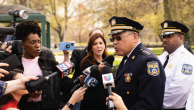The study takes an elemental approach to measuring what a “good” newscast is.
A “design team” of local TV professionals defined quality as succeeding on the nuts and bolts of journalism, things like being fair, relevant, and enterprising. To measure these, the study gauges stories by a set of easily quantifiable fundamentals, such as the number of sources. Here is a summary of the design team’s ideas and how they’re measured.
Topic Range
Reflecting the community in its totality is the preeminent concern. No topic should be considered off limits. The problem is what local TV “doesn’t cover.” So one yardstick is a ratio of the topics covered in a newscast divided by the number of stories. The greater the range of topics, the better the index.
Story Focus
Newscasts should be significant and informative — as well as interesting. Topic matters less than treatment. Thus, the study measures the focus of each story. Was it a larger issue or trend that affected a lot of people? Was it a public malfeasance? Was it a major, unusual event? Or was it an everyday incident, an everyday crime, human interest, celebrity/scandal or popular culture?
Enterprise Level
Being gutsy, providing depth and context, showing initiative, and demonstrating enterprise are also prime values. This variable measures how much effort went into a story. Was it a station-initiated investigation, interview, or series? Was the station responding to spontaneous or pre-arranged events? Was the story simply taken from the news wire or a feed from another source, or was it based on rumors or gossip? The more enterprise, the higher the score.
Number of Sources
Being accurate, credible, fair, balanced and honest are important. As a first step, this measurement simply counts how many sources there were in a story, or whether any sourcing was even required.
Viewpoints
As a second way of measuring balance, fairness and credibility, this index notes whether the story had multiple points of view (no one view accounted for 75% of the story), made only a passing reference to a second point of view, or contained only one point of view. Stories presented as undisputed (a fire, the weather) were noted separately.
Source Expertise
Newscasts should be authoritative to be credible. A good yardstick is the quality of one’s sources. This variable notes whether the source on the given topic was a credentialed expert, impartial data, the major actor in the story, a person on the street, an unnamed source, or finally whether no source was cited.
Local Relevance
Because reflecting the community and being relevant stands out with accuracy and fairness as primary values, this variable measures the local connection. Did the story affect citizens in the whole area, important institutions in the area, major demographic or geographic groups in the area, smaller subgroups? Or was it interesting but with no direct connection to the community?
The study also codes stories, though allotting minimal points, for presentation. Was the story understandable or not? The study, finally, also noted whether stories were sensational, which was defined as replaying video or graphics beyond the point that added new information.
The design team does not think all stories should be alike. A story about big ideas might get more points than one about a commonplace event, but any story done well scored high. Stations that covered a lot of topics well scored the highest.
What didn’t win points is notable. Topic is considered neutral. A crime story might score as high as a science piece. Stories earn no points for length. Production techniques are considered tools and not rated. The study avoids rating subjective qualities such as tone or negativity.
Last, if one does not agree with the design team’s frankly quite basic “values,” it is still possible to learn from these measurements. The values mainly note how stories were put together. One can ignore the quality scores, and simply track which newscast characteristics audiences respond to via the ratings data.




